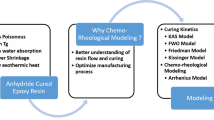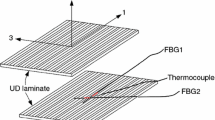Abstract
The precise control of curing reaction parameters allows a better crosslinking polymer. Modelling and optimization of this process require a correct kinetic of curing model. The kinetics of the crosslinking reaction is studied for the ethylene propylene diene monomer (EPDM) synthetic elastomer by mobile die rheometer (MDR). The kinetic parameters of reaction were calculated from Kamal-Ryan, Sestak-Berggren, and the Isayev-Deng methods at different temperatures. An Arrhenius-type function for the order of reaction n is introduced to improve the adjusting. Finally, a graphical and analytical description of the cure kinetics was developed. The order of reaction is predicted to better establishment of processing time. It was noted that for EPDM at higher temperatures, the increase of the rate of reaction occurs in short period of time, which could cause premature curing if the supply system is inadequate.
Similar content being viewed by others
References
R. Pantani, “Validation of a model to predict birefringence in injection molding,” European Polymer Journal, vol. 41, no. 7, pp. 1484–1492, 2005/07/01/2005.
M. A. López-Manchado, M. Arroyo, B. Herrero, and J. Biagiotti, “Vulcanization kinetics of natural rubber-organoclay nanocomposites,” Journal of Applied Polymer Science, vol. 89, no. 1, pp. 1–15, 2003.
N. C. Restrepo-Zapata, B. Eagleburger, T. Saari, T. A. Osswald, and J. P. Hernández-Ortiz, “Chemorheological time-temperature-transformation-viscosity diagram: Foamed EPDM rubber compound,” Journal of Applied Polymer Science, vol. 133, no. 38, pp. n/a–n/a, 2016.
I.-K. Hong and S. Lee, “Cure kinetics and modeling the reaction of silicone rubber,” Journal of Industrial and Engineering Chemistry, vol. 19, no. 1, pp. 42–47, 2013.
M. A. Kader and C. Nah, “Influence of clay on the vulcanization kinetics of fluoroelastomer nanocomposites,” Polymer, vol. 45, no. 7, pp. 2237–2247, 2004.
G. Milani and F. Milani, “A new simple numerical model based on experimental scorch curve data fitting for the interpretation of sulphur vulcanization,” Journal of Mathematical Chemistry, Article vol. 48, no. 3, pp. 530–557, 2010.
G. Milani and F. Milani, “EPDM accelerated sulfur vulcanization: a kinetic model based on a genetic algorithm,” Journal of mathematical chemistry, vol. 49, no. 7, pp. 1357–1383, 2011.
G. Milani and F. Milani, “COMPREHENSIVE NUMERICAL MODEL FOR THE INTERPRETATION OF CROSS-LINKING WITH PEROXIDES AND SULFUR: CHEMICAL MECHANISMS AND OPTIMAL VULCANIZATION OF REAL ITEMS,” Rubber Chemistry and Technology, vol. 85, no. 4, pp. 590–628, 2012.
G. Milani and F. Milani, “Kinetic finite element model to optimize sulfur vulcanization: Application to extruded epdm weather-strips,” Polymer Engineering & Science, vol. 53, no. 2, pp. 353–369, 2013.
X. Sun and A. I. Isayev, “Cure Kinetics Study of Unfilled and Carbon Black Filled Synthetic Isoprene Rubber,” Rubber Chemistry and Technology, vol. 82, no. 2, pp. 149–169, 2009.
J. Šesták and J. Kratochvíl, “Rational approach to thermodynamic rrocesses and constitutive equations in isothermal and non-isothermal kinetics,” Journal of Thermal Analysis and Calorimetry, vol. 5, no. 2–3, pp. 193–201, 1973.
X. Huang and B. Patham, “Experimental characterization of a curing thermoset epoxy-anhydride system—Isothermal and nonisothermal cure kinetics,” Journal of Applied Polymer Science, vol. 127, no. 3, pp. 1959–1966, 2013.
B. Janković, “The kinetic analysis of isothermal curing reaction of an unsaturated polyester resin: Estimation of the density distribution function of the apparent activation energy,” Chemical Engineering Journal, vol. 162, no. 1, pp. 331–340, 2010/08/01/2010.
M.-R. Erfanian, M. Anbarsooz, and M. Moghiman, “A three dimensional simulation of a rubber curing process considering variable order of reaction,” Applied Mathematical Modelling, vol. 40, no. 19, pp. 8592–8604, 2016/10/01/2016.
A. Arrillaga, A. M. Zaldua, R. M. Atxurra, and A. S. Farid, “Techniques used for determining cure kinetics of rubber compounds,” European Polymer Journal, vol. 43, no. 11, pp. 4783–4799, 2007.
T. Khang and Z. Ariff, “Vulcanization kinetics study of natural rubber compounds having different formulation variables,” Journal of Thermal Analysis & Calorimetry, Article vol. 109, no. 3, pp. 1545–1553, 2012.
M. R. Keenan, “Autocatalytic cure kinetics from DSC measurements: Zero initial cure rate,” Journal of Applied Polymer Science, vol. 33, no. 5, pp. 1725–1734, 1987.
L. M. Lopez, A. B. Cosgrove, J. P. Hernandez-Ortiz, and T. A. Osswald, “Modeling the vulcanization reaction of silicone rubber,” Polymer Engineering & Science, vol. 47, no. 5, pp. 675–683, 2007.
M. Rafei, M. H. R. Ghoreishy, and G. Naderi, “Development of an advanced computer simulation technique for the modeling of rubber curing process,” Computational Materials Science, vol. 47, no. 2, pp. 539–547, 2009/12/01/2009.
O. H. Yeoh, “MATHEMATICAL MODELING OF VULCANIZATION CHARACTERISTICS,” Rubber Chemistry and Technology, vol. 85, no. 3, pp. 482–492, 2012.
M. R. Kamal and S. Sourour, “Kinetics and thermal characterization of thermoset cure,” Polymer Engineering & Science, vol. 13, no. 1, pp. 59–64, 1973.
C. Albano, M. Hernández, M. N. Ichazo, J. González, and W. DeSousa, “Characterization of NBR/bentonite composites: vulcanization kinetics and rheometric and mechanical properties,” Polymer Bulletin, journal article vol. 67, no. 4, pp. 653–667, August 01 2011.
M. H. R. Ghoreishy, M. Rafei, and G. Naderi, “OPTIMIZATION OF THE VULCANIZATION PROCESS OF A THICK RUBBER ARTICLE USING AN ADVANCED COMPUTER SIMULATION TECHNIQUE,” Rubber Chemistry and Technology, vol. 85, no. 4, pp. 576–589, 2012.
W. I. Lee, A. C. Loos, and G. S. Springer, “Heat of Reaction, Degree of Cure, and Viscosity of Hercules 3501–6 Resin,” Journal of Composite Materials, vol. 16, no. 6, pp. 510–520, 1982.
Author information
Authors and Affiliations
Rights and permissions
About this article
Cite this article
Gómez-Jimenez, S., Becerra-Ferreiro, A.M., Jareño-Betancourt, E. et al. Phenomenological model for the reaction order n in the kinetics of curing an elastomer EPDM. MRS Advances 4, 3299–3310 (2019). https://doi.org/10.1557/adv.2019.428
Published:
Issue Date:
DOI: https://doi.org/10.1557/adv.2019.428




